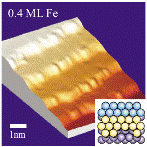Authors
Jan Honolka, Max-Planck-Institut für FestkörperforschungFollow
T. Y. Lee, Max-Planck-Institut für Festkörperforschung
K. Kuhnke, Max-Planck-Institut für Festkörperforschung
D. Repetto, Max-Planck-Institut für Festkörperforschung
V. Sessi, Max-Planck-Institut für FestkörperforschungFollow
Peter Wahl, Max-Planck-Institut für FestkörperforschungFollow
A. Buchsbaum, Technische Universität Wien
P. Varga, Technische Universität Wien
S. Gardonio, 3Istituto di Struttura della Materia, Consiglio Nazionale delle Ricerche, Trieste, Italy
C. Carbone, Istituto di Struttura della Materia, Consiglio Nazionale delle Ricerche, Trieste, Italy
S. R. Krishnakumar, International Centre for Theoretical Physics (ICTP), Trieste, Italy
P. Gambardella, Institució Catalana de Recerca i Estudis Avançats (ICREA), Bellaterra, Spain
M. Komelj, Jožef Stefan Institute, Ljubljana, Slovenia
R. Singer, Max-Planck-Institut für Metallforschung
M. Fähnle, Max-Planck-Institut für Metallforschung
K. Fauth, Max-Planck-Institut für Metallforschung
G. Schütz, Max-Planck-Institut für Metallforschung
Axel Enders, University of Nebraska-LincolnFollow
K. Kern, École Polytechnique Fédérale de LausanneFollow
Date of this Version
2009
Abstract
Correlations between magnetism and morphology of iron nanostructures of monatomic height on Pt(997) substrates are studied using x-ray magnetic circular dichroism as well as scanning tunneling microscopy and helium scattering. A drastic collapse of the average magnetization by more than a factor of 4 is observed when increasing the iron coverage from 0.1 to 0.2 ML. This effect goes along with a softening of the magnetic anisotropy energy and a gradual reorientation of the magnetic easy axis from in plane to out of plane. The experimental findings together with electronic density-functional calculations suggest the formation of a complex magnetic phase in corrugated rim regions of Fe islands, leading to both ferromagnetic and antiferromagnetic exchange couplings of Fe moments depending on their various local bonding configurations.



Comments
Published in PHYSICAL REVIEW B 79, 104430 (2009); DOI: 10.1103/PhysRevB.79.104430 ©2009 The American Physical Society. Used by permission.